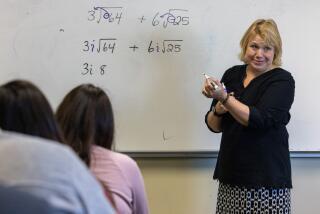Career Additions : A Math Class for Businesswomen, Minus the Fear
For many high school and college students, the last day of the last math class signals the end of a particular kind of fear and loathing. No more thought problems. No more algebraic gibberish. No more undecipherable geometric theorems. They’re through with math, forever.
But many professional women are finding out that it isn’t necessarily so. Some of them--all businesswomen, most of them managers--sit in a classroom every other Saturday at USC’s Orange County Center in Irvine trying to learn a new approach to mathematics. In a sense the victims of their own career advancement, they have been promoted into positions where business mathematics plays a significantly more important role.
It is the job of Anne Kimbell Relph and a handful of teachers to make sure that math anxiety does not return with it.
“Many of them have had math in high school and some in college--at least algebra--but haven’t been using it in their jobs until now,” said Relph, the creator and director of the program, known as the Certificate in Management Effectiveness for Women. “Now they’re at a place in their careers where they’re expected to know (math).”
The course, which Relph said is in its fifth year, consists of about 50% math or math-related subjects such as business mathematics, accounting and business finance. Classes in business law, business communication, computers and strategic planning and marketing also are offered.
The students, she said, are business professionals usually between the ages of 28 and 50 who have often had many years of experience in the business world but find, for a myriad of reasons, that their skills have become less adequate as their careers have progressed.
Class Calms Fears
In particular, Relph said, the class calms fears associated with business-related math, stresses practicality and teamwork, and encourages frequent questioning.
“We give people a lot of chances to say, ‘Hey, I don’t understand.’ If you don’t do that, it can be just disastrous in math. Many of the students have never been in an environment where that’s OK. Math has been taught as an absolute, that it’s a subject where there’s only one right answer and you’re a dummy if you don’t get the right answer.
“Good mathematicians look at math as a creative function. We stress that you understand the concept--for instance, the time value of money. If you don’t understand the concept, it isn’t going to do you any good to crunch it out on the calculator. Business math isn’t higher mathematics. There are about 10 main concepts that you have to know.”
The daylong classes are held every other Saturday for eight months. No grades are given, but six hours of homework is assigned each week and study groups meet between classes, Relph said. The course is open to women with a minimum of three years of experience in management who have had some college education. Tuition is $3,200.
‘Stronger Emphasis on Math’
Relph said she knew of only one other management program for women similar to USC’s--at Simmons College in Boston--”but we put a much stronger emphasis on math.”
The interdependence between students, Relph said, is partly responsible for the low attrition rate. Out of about 35 class members in the Orange County section (a second section is taught at USC’s main campus) only one or two drop out each semester, she said.
The average student, according to the course brochure, is 36 years old, earns between $25,000 and $65,000 a year, and has been in the workplace for 12 years.
Many students’ careers are in transition. Susan Zajfen of Laguna Beach, who has a degree in nursing, recently left an Orange County biomedical firm. She says she wants to find a position in the medical device business.
“I recognized that my math skills were OK in high school,” Zajfen said, “but my living has never depended on that. I have math anxiety, but I’m overcoming that.”
Alice Burroughs of Yorba Linda, who works for an Anaheim retailer, said she has been in business for 25 years and a manager for 15, but “at first, with math, I felt very low in my ability. This course dredges up old philosophies and terms, and after a while your confidence level slowly increases.”
Denise McGregor, a former teacher and high school counselor who now runs a plant sales business in Encinitas with her husband, said she “didn’t have a lot of math anxiety coming in,” but that she is finding that the course “fills in the gaps when you’re turning from the humanities to business. (In the class study groups) you learn to work together as a team and be supportive of each other.”
It is that we’re-all-in-this-together atmosphere that helps many of the students not only get through the course but even flourish in a math- and business-jargon-laden world, a pair of course graduates said.
“There’s no high-blown theory. You can immediately apply your knowledge in the workplace,” said Vicki Bush, who operates her own property management firm in Huntington Beach. “It (the classroom) was a very non-threatening environment, and we could be very repetitious if we had to and no one felt self-conscious because of that.
“I think that was partly because there were no men in the room. Often when a man is there a woman automatically feels that she can’t verbalize her discomfort or lack of understanding of a concept. Also, men are less likely to be sharing or give a measure of disclosure, whereas women seem more able to show their inadequacy to other women.”
Often, anxiety is heaped upon anxiety when the terrors of math are coupled with technical and business jargon, said Shirley Gilbert, another alumna and a vice president of Imperial Bank in Costa Mesa.
“About 90% of my class had math anxiety, I think,” she said. “And for many of us, the jargon was an intimidating thing. Attorneys, accountants and financial planners use it to intimidate in the business world. But in class we broke down the jargon and put everything back together in an understandable way.”
Dr. John Lacey, a professor from the USC School of Business, taught a class in accounting on a recent Saturday at the Orange County Center in which he illustrated the “last-in, first-out” theory of accounting by likening it to a bin of pinto beans at the supermarket and described the “weighted average concept” in terms of pea soup mixed with clam chowder.
“I try to give them the nuts and bolts,” Lacey said, “the things they can go out and apply right away. I try to get across to them that accounting isn’t ‘right,’ that there are a lot of different answers. I see a couple of people still mystified, but most have really gotten it together.”
And sometimes, Relph said, students are so pleased when the old mystery of math begins to unravel that they engage in a little intellectual muscle flexing on their own.
“We’ve actually gotten all kinds of spinoffs from the classes,” she said. “We’ve even had people forming investment clubs. They’ve really turned their anxiety around.”
More to Read
Inside the business of entertainment
The Wide Shot brings you news, analysis and insights on everything from streaming wars to production — and what it all means for the future.
You may occasionally receive promotional content from the Los Angeles Times.










